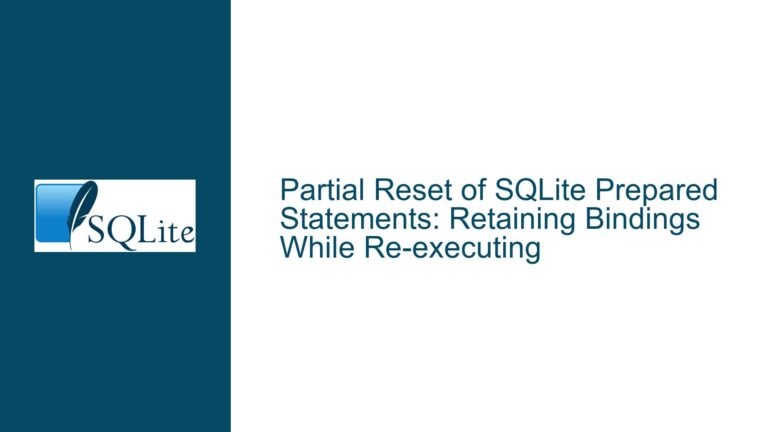Updating SQLite Table Field Using Values from Another Table
Understanding the Core Problem: Updating inventory.component Based on tmp.replacement_val
The core issue revolves around updating a field in the inventory table using values from another table, tmp, when certain conditions are met. Specifically, the goal is to update the component column in the inventory table with the value from tmp.replacement_val only when two conditions are satisfied:
- The
inventory.componentmatchestmp.current_val. - The
tmp.current_valis not equal totmp.replacement_valfor the same record.
This scenario is common in database operations where data normalization or synchronization between tables is required. However, the challenge lies in ensuring that the update operation is both correct and efficient, especially when dealing with large datasets or complex relationships between tables.
The original query attempts to achieve this by using a subquery in the SET clause of the UPDATE statement, combined with an EXISTS clause in the WHERE condition. While this approach is logically sound, it raises questions about performance, readability, and whether there are simpler or more efficient ways to achieve the same result.
Potential Pitfalls and Misunderstandings in the Query Design
One of the primary concerns with the original query is the use of a subquery in the SET clause. Subqueries in UPDATE statements can be tricky because they must return exactly one row for each row being updated. If the subquery returns more than one row, SQLite will throw an error. In this case, the subquery is designed to return a single value (tmp.replacement_val) based on the conditions specified, but it’s essential to ensure that the conditions are written in a way that guarantees this.
Another potential issue is the use of the EXISTS clause in the WHERE condition. While this ensures that the update only occurs when there is a matching record in the tmp table, it doesn’t explicitly enforce the condition that tmp.current_val must not equal tmp.replacement_val. This could lead to unnecessary updates if the tmp table contains records where current_val and replacement_val are the same.
Additionally, the original query does not take advantage of SQLite’s UPDATE FROM syntax, which can simplify the query and potentially improve performance. The UPDATE FROM syntax allows you to join the inventory and tmp tables directly in the UPDATE statement, making the query more readable and easier to maintain.
Step-by-Step Troubleshooting and Optimized Solutions
To address the issues outlined above, let’s break down the problem and explore optimized solutions step by step.
Step 1: Validate the Data and Schema
Before writing or optimizing any query, it’s crucial to understand the structure of the tables involved and the data they contain. Here’s a simplified version of the schema based on the discussion:
CREATE TABLE tmp (
current_val,
replacement_val
);
CREATE TABLE inventory (
component
);
In this schema, the tmp table contains two columns: current_val and replacement_val. The inventory table contains a single column, component, which needs to be updated based on the values in the tmp table.
To ensure the query works as intended, we need to verify that:
- The
tmptable contains no duplicatecurrent_valentries. If there are duplicates, the subquery in theSETclause could return multiple rows, causing an error. - The
inventory.componentvalues are consistent with thetmp.current_valvalues. If there are mismatches, the update operation might not affect any rows.
Step 2: Rewrite the Query Using UPDATE FROM
The UPDATE FROM syntax is a powerful feature in SQLite that allows you to join tables directly in an UPDATE statement. This eliminates the need for subqueries in the SET clause and makes the query more readable. Here’s how the query can be rewritten using UPDATE FROM:
UPDATE inventory
SET component = tmp.replacement_val
FROM tmp
WHERE inventory.component = tmp.current_val
AND tmp.current_val != tmp.replacement_val;
In this version of the query:
- The
FROM tmpclause joins theinventorytable with thetmptable. - The
SET component = tmp.replacement_valclause updates thecomponentcolumn in theinventorytable with the correspondingreplacement_valfrom thetmptable. - The
WHEREclause ensures that the update only occurs wheninventory.componentmatchestmp.current_valandtmp.current_valis not equal totmp.replacement_val.
This approach is not only simpler but also more efficient because it avoids the overhead of executing subqueries for each row in the inventory table.
Step 3: Handle Edge Cases and Validate Results
While the UPDATE FROM syntax simplifies the query, it’s essential to consider edge cases and validate the results to ensure the update operation behaves as expected.
Edge Case 1: Duplicate current_val in tmp Table
If the tmp table contains multiple rows with the same current_val, the UPDATE FROM query will update the inventory table with the replacement_val from the last matching row in the tmp table. To avoid this, ensure that the tmp table has unique current_val entries or use additional conditions to filter the correct row.
Edge Case 2: No Matching Rows
If there are no rows in the tmp table that satisfy the conditions in the WHERE clause, the UPDATE statement will not affect any rows in the inventory table. This is the expected behavior, but it’s important to verify that the tmp table contains the necessary data before running the query.
Edge Case 3: tmp.current_val Equals tmp.replacement_val
The query explicitly excludes rows where tmp.current_val equals tmp.replacement_val. This ensures that the inventory table is only updated when there is a meaningful change. However, if the tmp table contains many such rows, the query might still perform unnecessary checks. To optimize further, consider filtering out these rows in a preliminary step.
Step 4: Test the Query with Sample Data
To ensure the query works as intended, test it with sample data that covers various scenarios, including edge cases. Here’s an example:
-- Sample data for tmp table
INSERT INTO tmp (current_val, replacement_val) VALUES
('A', 'B'),
('C', 'D'),
('E', 'E'), -- current_val equals replacement_val
('F', 'G');
-- Sample data for inventory table
INSERT INTO inventory (component) VALUES
('A'),
('C'),
('E'),
('F'),
('H'); -- No matching current_val in tmp
-- Run the UPDATE FROM query
UPDATE inventory
SET component = tmp.replacement_val
FROM tmp
WHERE inventory.component = tmp.current_val
AND tmp.current_val != tmp.replacement_val;
-- Verify the results
SELECT * FROM inventory;
After running the query, the inventory table should be updated as follows:
- The row with
component = 'A'should now havecomponent = 'B'. - The row with
component = 'C'should now havecomponent = 'D'. - The row with
component = 'E'should remain unchanged becausetmp.current_valequalstmp.replacement_val. - The row with
component = 'F'should now havecomponent = 'G'. - The row with
component = 'H'should remain unchanged because there is no matchingcurrent_valin thetmptable.
Step 5: Optimize for Performance
For large datasets, performance can become a concern. Here are some tips to optimize the query:
Indexes: Ensure that the
tmp.current_valandinventory.componentcolumns are indexed. This will speed up the join operation in theUPDATE FROMquery.CREATE INDEX idx_tmp_current_val ON tmp(current_val); CREATE INDEX idx_inventory_component ON inventory(component);Filter Unnecessary Rows: If the
tmptable contains many rows wherecurrent_valequalsreplacement_val, consider filtering these rows before running the update. This can be done using aWITHclause or a temporary table.Batch Updates: For extremely large tables, consider breaking the update into smaller batches to avoid locking the table for an extended period.
Step 6: Alternative Approaches
While the UPDATE FROM syntax is the most straightforward solution, there are alternative approaches that might be suitable depending on the specific requirements:
Using a Temporary Table: Create a temporary table that contains only the rows from
tmpwherecurrent_valdoes not equalreplacement_val. Then, use this temporary table in theUPDATE FROMquery.Using a Common Table Expression (CTE): A CTE can be used to pre-filter the
tmptable and simplify the main query.Using a Trigger: If the update operation needs to be performed frequently, consider using a trigger to automate the process.
Conclusion
Updating a field in one table using values from another table is a common task in SQLite, but it requires careful consideration of the schema, data, and query design. By understanding the core problem, identifying potential pitfalls, and following a structured troubleshooting approach, you can write efficient and reliable queries that meet your requirements. The UPDATE FROM syntax is a powerful tool that simplifies this process, but it’s essential to test and optimize your queries to handle edge cases and large datasets effectively.






